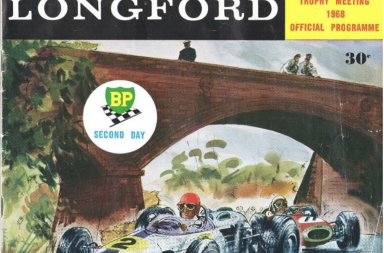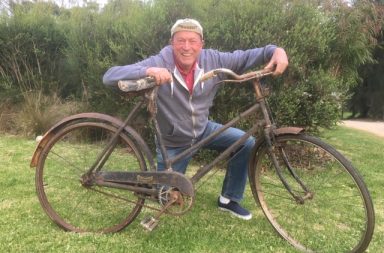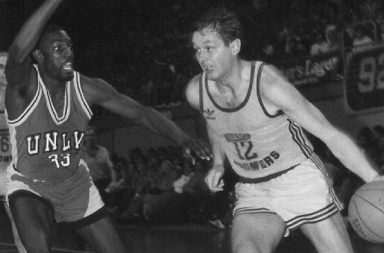Written 2006
Can one road take this much punishment?
Last weekend Tasmania’s ‘man mountain’, world champion axeman David Foster, rolled into the Southern capital to finish his 14th annual charity walk from the State’s north-west to Hobart.
Foster stands a whopping 193cm and 159kg, and is almost as round as he is high.
On an island where loggers have relentlessly desecrated the grandest icons, and tree-huggers are waging a bitter war, both sides let Foster stand as a protected species.
He’s a lumberjack and he’s okay.
At times when donations came slowly during the Giving Tree walk, his fellow collectors eased him nearer the middle of the highway and forced drivers to either pull up or bust their bull bars.
He confronted them, rattling his bucket, like a stud bull meeting a line of cows on the way to milking.
The Giving Tree appeal is not just Tasmania’s biggest charity fundraiser – it has collected over a million dollars for the underprivileged – it is also the closest most Taswegians come to gridlock.
Some folks in the north and north-west can’t see a reason to go beyond their woodpile, let alone to watch the traffic lights change in the State capital.
But the bush telegraph burns like grassfire.
Auntie Mary at South Yolla knows by dinner time if the Governor is a goose and Foster’s good deeds are legend – as well documented as the big wood-chopper’s food intake.
Grocery wholesalers index their supply to Foster’s consumption.
They trembled one morning last week when news leaked during the walk that he had eight boiled eggs and two kilograms of bacon for breakfast.
The big man was off his tucker, obviously, but was back to his regulation dozen eggs next day.
Spuds are his staple. He took to them when he was a yearling and has never let go.
His dad, George, couldn’t find anything except boxes of Brownells to feed one year-old David when mum was in hospital waiting to give birth to their next son.
George mashed the spuds in a billy of milk and spooned them down boy David’s throat until his arms got tired.
George was a world champion woodchopper, an ox, so he emptied several boxes.
“David done well on them spuds,” George told me years later.
Mrs Foster didn’t recognize her son when she came home from giving birth.
There are dozens of anecdotes about David’s exploits on the Giving Tree walk.
I will share two that I know to be true.
A few years ago he boarded a tourist coach in the midlands, a menacing sight in his tight-fitting singlet with axe logo, and the busload of middle-aged Japanese tourists were startled.
Foster thought he’d play along with the joke, and demanded they empty their purses and wallets.
The bus driver tried to explain Foster’s presence, but the Japanese hastily handed over hundreds of dollars and several cameras.
Only after they fled did Foster realise the tourists didn’t know who he was.
Another time, the 15 collectors who walk with Foster were in a country hostelry, when the publican told them about a deserted mother of four who was dirt poor.
He explained that she was too proud to accept charity.
Foster cobbled together a barrow full of groceries, wheeled it to the woman’s door, and started knocking.
“Are you Mrs …….?” he asked, telling her that she had won the pub raffle.
When the woman backed away, saying she couldn’t have bought a ticket, Foster insisted that someone must have put her name down.
She took more convincing, but Foster was never going to take no for an answer.
No wonder he was named Tasmanian of the Year in 1995 and again this year, even though he couldn’t take his 1995 prize (an economy class flight to Europe) because he couldn’t fit in the seats.
There is only one David Foster – but, either by good luck or by a freak of genetics that could only be explained in Tasmania – David has a twin.
Not quite Schwarzenneger and De Vito, but David Foster and David Boon are like slabs from an ironbark.
Both laconic sportsmen, both horizontally challenged, they are Tasmania’s two best-known residents.
The difference is that David Foster OAM swung an axe and cleared the path less traveled, while David Boon MBE wielded the willow in our national pastime.
He was a foundation stone on which Australia’s cricket supremacy was built.
Eight years after his final Test innings, Boonie is about to reveal a side of his sporting make-up which wasn’t as apparent as his bottomless spirit and old-fashioned guts.
He is going to walk.
Not in the cricket sense, which Boonie still abhors.
He is going to set on Tuesday on a 20-day walk which will take him from the MCG, then a quick boat ride to Tassie, before he leads “Boonie’s Walk For Hope” from Burnie down the highway to Hobart.
The bitumen of the Bass Highway, still recovering from the bruising effects of Foster’s Dunlop volleys, will have to absorb the thumping impact of Boonie’s frantic steps.
Unlike Foster, who raises money by being a roadblock not a roadrunner, Boonie reckons he has been doing 30km a day and seeking advice from athletes to prepare himself physically and mentally.
When I rang him last week, he was in Perth, 45 minutes into a three hour walk, puffing continually as he tried to talk.
The illusion of a lean, taut “five foot five inch Tasmanian wearing flared pants” took a hammering next morning when a picture appeared in the Herald Sun of Boonie in figure-hugging shirt inspecting the WACA wicket.
But D.Boon never backed away from a challenge, however big.
He has set his target at raising half a million dollars for the Bone Marrow Donor Institute.
“No point in settin’ the sights too low,” he puffed.
Ian Botham pioneered charity walks in the 1980s, and he issued the challenge to Allan Border and Dean Jones when he goaded them by saying Australians didn’t do enough for charity.
After Boon assisted on their walks, Border and Jones will return the favour next week, with Merv Hughes, Ian Healy and Mark Taylor adding to Boonie’s enormous pulling power.
They will start in Burnie, swing through Boonie’s old stomping ground in Launceston, then take the coast road to his adopted home town, Hobart.
It’s going to be an unforgettable summer for Tasmania’s travelers.
Two traffic jams in a month is unthinkable.
The highway will never be the same.



